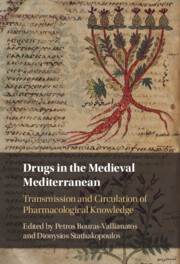Book contents
- Drugs in the Medieval Mediterranean
- Drugs in the Medieval Mediterranean
- Copyright page
- Contents
- Figures
- Tables
- Contributors
- Acknowledgements
- Note to the Reader
- Medieval Mediterranean Pharmacology
- Part I Transmission of Pharmacological Knowledge
- Chapter 1 Ibn al-Tilmīdh’s Book on Simple Drugs
- Chapter 2 Drugs, Provenance, and Efficacy in Early Medieval Latin Medical Recipes
- Chapter 3 De sexaginta animalibus
- Chapter 4 Arabic Terms in Byzantine Materia Medica
- Chapter 5 The Theriac of Medieval al-Shām
- Chapter 6 ‘Already Verified’
- Part II The Borders of Pharmacology
- Index
- References
Chapter 3 - De sexaginta animalibus
A Latin Translation of an Arabic Manāfiʿ al-ḥayawān Text on the Pharmaceutical Properties of Animals
from Part I - Transmission of Pharmacological Knowledge
Published online by Cambridge University Press: 19 October 2023
- Drugs in the Medieval Mediterranean
- Drugs in the Medieval Mediterranean
- Copyright page
- Contents
- Figures
- Tables
- Contributors
- Acknowledgements
- Note to the Reader
- Medieval Mediterranean Pharmacology
- Part I Transmission of Pharmacological Knowledge
- Chapter 1 Ibn al-Tilmīdh’s Book on Simple Drugs
- Chapter 2 Drugs, Provenance, and Efficacy in Early Medieval Latin Medical Recipes
- Chapter 3 De sexaginta animalibus
- Chapter 4 Arabic Terms in Byzantine Materia Medica
- Chapter 5 The Theriac of Medieval al-Shām
- Chapter 6 ‘Already Verified’
- Part II The Borders of Pharmacology
- Index
- References
Summary
This chapter will discuss a Latin translation of an Arabic text on the pharmacological uses of the individual body parts of animals. De sexaginta animalibus is placed in the context of its original Arabic genre of works on the useful or occult virtues of animals, minerals, and plants. This is the first detailed scholarly treatment of this text, which has been mentioned in passing by other scholars. It argues that it is a translation of a work on the properties of the body parts of animals by the eleventh-century physician ʿUbaydallāh ibn Bukhtīshūʿ, by comparing the text with the manāfiʿ (usefulness) section from an Arabic Ibn Bukhtīshūʿ bestiary. Other issues covered include the copious use of transliterated Arabic terminology, particularly in regard to the names of the numerous animals themselves and confusion in their identification, the order of the animals (which aids identification of partial copies of the manuscript), cited authorities, and ascribed authorship. The chapter also argues for the existence of two recensions of the text in the manuscript tradition, with a comparison of an entry found in both recensions with the Ibn Bukhtīshūʿ text and ʿĪsā ibn ʿAlī’s Book on the Useful Properties of Animal Parts.
Keywords
- Type
- Chapter
- Information
- Drugs in the Medieval MediterraneanTransmission and Circulation of Pharmacological Knowledge, pp. 104 - 129Publisher: Cambridge University PressPrint publication year: 2023

